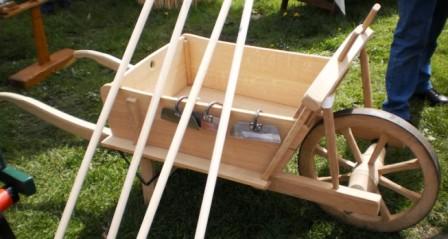For a wheel barrow one wheel is sufficient. Insert a shaft. Attach on the shaft on each side of the wheel a long, with respect to each other increasingly wider flared pole. Connect the two handles with a platform. That is the basic model.
 Make before the wheel a protective board, so the burden is not loaded up against the wheel.
Make before the wheel a protective board, so the burden is not loaded up against the wheel.
Below each handle you may make a leg, approximately half the height of the wheel. Then you should not have to bend so deep down to pick up the handles.
Depending on the load (leaves, soil, manure...), you should also make (optionally removable or increasable) side boards (braiding, shelves...).
For heavy loads they used to have (measure and fit) a strap that ran over the shoulders, and hung with two loops around the handles.
There are also models where the platform rather than behind the wheel is mounted over the wheel. By leveraging rest less weight on your arms, and more at the wheel. But they are more difficult to hold in balance. With an unbalanced load you have to keep them crooked. Thus, the Chinese wheelbarrow had a very large central wheel. Sometimes they used a donkey or even a sail to have more traction.
Wheelbarrow, also called wooden ox (pulled) or plain horse (pushed), would have been invented by Ko Joe.
Chinese Minister Zhude Liang (181-234) had him used to transport wounded soldiers during his campaigns. This strategic advantage (also to provide fast) was kept secret.
In Europe, he only appeared in the 11th or 12th century.
If you have two wheels on an axle you can make of a trolley. (An L –shape, wheels in the bottom corner.) Very convenient to, without back injury, to lug fairly heavy loads on your own.
And with even bigger wheels, wider apart, you make a cart.
Possibly for a dog, a donkey, ox or horse. Not forget a brake.
(If you have four wheels used, one axis should be able to rotate to still be able to make turns in a reasonable way.)
Ensure that moving parts are smooth and lubricated. Less friction makes the job easier.
